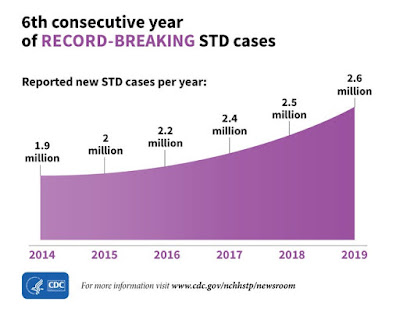By: Jonathan J. Pena, MSW, Licensed Clinical Social Work Associate (LCSWA)
In life, being at the top has always been a driving force of accomplishments, recognition, and even bragging rights. We see this playout in areas like sports, personal careers, and even friendly rivalries between family and friends. However, rising to the top isn’t always a place that you would want to find yourself in. Sexually transmitted diseases (STDs) have been on the rise for six uninterrupted years.
The Center for Disease Controls and Prevention (CDC) released data demonstrating that “more than 2.5 million cases of chlamydia, gonorrhea, and syphilis” were reported in 2019.[1] In their last report in 2014, 1.4 million cases were reported giving way to a 1.1 million increase in cases to date. Some states have reached the top ten list of states with the highest cases of either chlamydia, gonorrhea, or syphilis. Additionally, the rises in STD’s exposes what communities are being hit hardest.
 |
| Photo Source: USA Today |
Chlamydia is a curable infection, but it can be spread through vaginal, oral and anal sex with an infected person. States like New York, Illinois, North Carolina, Georgia, Alabama, Alaska, Louisiana, Mississippi, South Carolina, and New Mexico ranked in the top ten with the highest cases of chlamydia. New Hampshire has the lowest total cases of 2019.[2]
Gonorrhea cases were highest in Mississippi, South Carolina, Alaska, Alabama, Oklahoma, Louisiana, Missouri, South Dakota, North Carolina, and Tennessee. Much like Chlamydia, Gonorrhea is a common STD and spread in the exact same way. However, there are some important factors that set it apart. First, “young people ages 15-24 years” are being infected and like other infections, this can present complications for a pregnant mother as she can pass the infection to their child at birth.[3] This infection is curable but drug-resistant strains have emerged making it harder and harder to treat the infection. Vermont is the state with the lowest cases.
Like the previous two infections, Syphilis is spread sexually by an infected person with a syphilitic sore or otherwise known as a chancre sore.[4] Also, like the previous infections, syphilis can be spread to a new-born child during birth from an infected mother. According to the CDC, if a mother does not treat her infection, congenital syphilis can lead to “miscarriages, premature births, stillbirths, and deaths of newborns.”[5] States that hit the top ten are New Mexico, Mississippi, Nevada, Oklahoma, California, Alaska, Arizona, Georgia, Florida, and Louisiana.
This data certainly is alarming, but these cases also bring to the surface all too familiar disparities that persevere within minority groups. When compared to non-Hispanic white people, STD rates were 1-2 times higher within Hispanic or Latino populations. American Indian, Alaska Native, Native Hawaiian, Pacific Islanders face rates 3-5 times greater than non-Hispanic white populations. African Americans face rates 5-8 times higher than non-Hispanic white populations.[6]
Marcus J. Hopkins, Operations Manager for the Community Education Group (CEG) & Project Manager for the Rural Health Service Providers Network, highlights some key factors in these findings. He states, “"When you look at the list of states where rates of STDs/STIs have skyrocketed, with rare exception, the same group of states saw dramatic increases—Alabama, Alaska, Georgia, Louisiana, Mississippi, North Carolina, Oklahoma, & South Carolina. These states share several characteristics: high levels of endemic poverty, significant barriers to accessing basic healthcare services, highly restrictive public health programs and systems, and low levels of health literacy.”
It isn’t hard to see how this statement from Marcus J. Hopkins rings true. These states have many pockets of rural communities which naturally present challenges in accessing healthcare miles from home. Rural communities also have a shortage of clinicians that are willing to work in these specific areas which further amplifies accessibility to healthcare services. Marcus J. Hopkins also adds, “outside of metro areas, it’s virtually unheard of for providers in rural areas to routinely test their patients for HIV, Viral Hepatitis, Chlamydia, Gonorrhea, and Syphilis. It is unconscionable for our public health infrastructure to serve only those in urban and suburban areas.”
 |
| Photo Source: USA Today |
While all groups experience STDs, minority groups continue to experience larger and larger disparities. Urban cities shouldn’t be the only hubs for healthcare accessibility nor the touchstones of greater public health care systems. Prominent public outreach is needed in rural communities that extends to not only access to healthcare services but also fosters programs that educate communities on the various and important aspect of health within a healthcare system. Minority populations also need targeted approaches to community health with clinicians of all kinds that culturally represent those within their communities. Representation matters because community members are more likely to seek services if there is an understanding that their healthcare system has clinicians, and programs, that understand their culture and thus can guide them towards a goal that addresses their specific needs.
These consecutive rising rates of STD’s don’t need to become an expected yearly occurrence. While more work needs to be done on a macro-level to bridge healthcare disparities, people living with HIV/AIDS can still rise to meet the importance of their personal health. Continue to stay active in your care of not only HIV treatment but also in the value of understanding how all aspects of healthcare strengthen the ability to continue to lead a healthier life.
Disclaimer: Guest blogs do not necessarily reflect the views of the ADAP Advocacy Association, but rather they provide a neutral platform whereby the author serves to promote open, honest discussion about public health-related issues and updates.
[1] Centers for Disease Control & Prevention (April 2021). Reported STDs in the U.S. reach all-time high for 6th consecutive year. U.S. Department of Health & Human Services. Retrieved online from: https://www.cdc.gov/std/statistics/2019/default.htm.
No comments:
Post a Comment